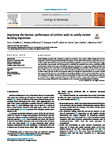Improving the thermal performance of earthen walls to satisfy current building regulations
| dc.contributor.author | Goodhew, Steve | |
| dc.contributor.author | Boutouil, M | |
| dc.contributor.author | Streiff, F | |
| dc.contributor.author | Le Guern, M | |
| dc.contributor.author | Carfrae, J | |
| dc.contributor.author | Fox, Matthew | |
| dc.date.accessioned | 2021-11-09T14:15:15Z | |
| dc.date.available | 2021-11-09T14:15:15Z | |
| dc.date.issued | 2021-06-01 | |
| dc.identifier.issn | 0378-7788 | |
| dc.identifier.issn | 1872-6178 | |
| dc.identifier.other | 110873 | |
| dc.identifier.uri | http://hdl.handle.net/10026.1/18257 | |
| dc.description.abstract |
Earth building materials offer architects, engineers and clients a low carbon walling solution for low rise properties (under 3 storeys). Unfortunately, the mixture of sub-soil and fibre known as Cob does not currently comply with the thermal aspects of many building regulations across the world. This paper designs and optimises a low-density cob mix intended to maintain the material's low carbon credentials whilst conforming to the thermal aspects of building regulations. Samples of a range of unmodified subsoils, dug from the ground near to the sites of some prospective buildings are described. These subsoils are combined with a range of commonly grown fibres. Practical and laboratory measurements are undertaken on these mixes and the results are compared with pure subsoil and separate fibres to provide a model that can predict the thermal conductivity of a theoretical soil-fibre mix. It was found that fibre contents over 50% gave very little reduction in thermal conductivity. Furthermore, if the optimal low-density mix is combined into a single composite 2-layer cob wall this can offer a ready-made solution for compliant low-carbon energy-efficient low rise properties or the extension of existing historic buildings. | |
| dc.format.extent | 110873-110873 | |
| dc.language | en | |
| dc.language.iso | en | |
| dc.publisher | Elsevier | |
| dc.subject | Cob | |
| dc.subject | Earth construction | |
| dc.subject | Thermal transmittance | |
| dc.subject | U-value | |
| dc.title | Improving the thermal performance of earthen walls to satisfy current building regulations | |
| dc.type | journal-article | |
| dc.type | Journal Article | |
| plymouth.author-url | https://www.webofscience.com/api/gateway?GWVersion=2&SrcApp=PARTNER_APP&SrcAuth=LinksAMR&KeyUT=WOS:000643673000004&DestLinkType=FullRecord&DestApp=ALL_WOS&UsrCustomerID=11bb513d99f797142bcfeffcc58ea008 | |
| plymouth.volume | 240 | |
| plymouth.publication-status | Published | |
| plymouth.journal | Energy and Buildings | |
| dc.identifier.doi | 10.1016/j.enbuild.2021.110873 | |
| plymouth.organisational-group | /Plymouth | |
| plymouth.organisational-group | /Plymouth/Faculty of Arts, Humanities and Business | |
| plymouth.organisational-group | /Plymouth/REF 2021 Researchers by UoA | |
| plymouth.organisational-group | /Plymouth/REF 2021 Researchers by UoA/UoA13 Architecture, Built Environment and Planning | |
| plymouth.organisational-group | /Plymouth/Users by role | |
| plymouth.organisational-group | /Plymouth/Users by role/Academics | |
| dcterms.dateAccepted | 2021-03-01 | |
| dc.rights.embargodate | 2022-3-6 | |
| dc.identifier.eissn | 1872-6178 | |
| dc.rights.embargoperiod | Not known | |
| rioxxterms.versionofrecord | 10.1016/j.enbuild.2021.110873 | |
| rioxxterms.licenseref.uri | http://www.rioxx.net/licenses/all-rights-reserved | |
| rioxxterms.licenseref.startdate | 2021-06-01 | |
| rioxxterms.type | Journal Article/Review |



